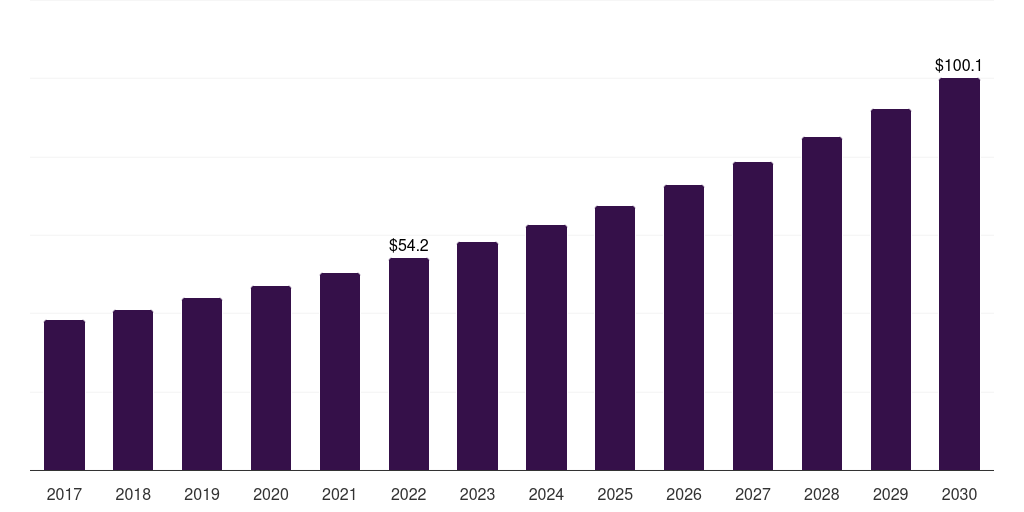UK Natural Food Color Market Size & Outlook, 2022-2030
UK natural food color market, 2017-2030 (US$M)

Related Markets
UK natural food color market highlights
- The UK natural food color market generated a revenue of USD 54.2 million in 2022 and is expected to reach USD 100.1 million by 2030.
- The UK market is expected to grow at a CAGR of 8% from 2023 to 2030.
- In terms of segment, beta carotene was the largest revenue generating ingredient in 2022.
- Blue Spirulina is the most lucrative ingredient segment registering the fastest growth during the forecast period.
Natural food color market data book summary
| Market revenue in 2022 | USD 54.2 million |
| Market revenue in 2030 | USD 100.1 million |
| Growth rate | 8% (CAGR from 2022 to 2030) |
| Largest segment | Beta carotene |
| Fastest growing segment | Blue Spirulina |
| Historical data | 2017 - 2021 |
| Base year | 2022 |
| Forecast period | 2023 - 2030 |
| Quantitative units | Revenue in USD million |
| Market segmentation | Beta Carotene, Lycopene, Curcumin, Anthocyanin, Carmine, Copper Chlorophyllin, Paprika, Betanin, Riboflavin, Blue Spirulina, Caramel, Annatto |
| Key market players worldwide | Naturex, Givaudan SA, Basf SE, Sensient Technologies Corp, Archer-Daniels Midland Co, Ingredion Inc, Vivify Health, Roquette America, Allied Biotech, Oterra, Roha Colors Group, Kalsec Inc, DohlerGroup, AromataGroup, IFC Solutions, Australian Food Ingredient Suppliers |
Other key industry trends
- In terms of revenue, UK accounted for 4.1% of the global natural food color market in 2022.
- Country-wise, U.S. is expected to lead the global market in terms of revenue in 2030.
- In Europe, Germany natural food color market is projected to lead the regional market in terms of revenue in 2030.
- UK is the fastest growing regional market in Europe and is projected to reach USD 100.1 million by 2030.
Key Regions: Brazil , U.S. , Japan , South Africa , Argentina
No credit card required*
Horizon in a snapshot
- 30K+ Global Market Reports
- 120K+ Country Reports
- 1.2M+ Market Statistics
- 200K+ Company Profiles
- Industry insights and more
Natural Food Color Market Scope
Natural Food Color Market Companies
| Name | Profile | # Employees | HQ | Website |
|---|
UK natural food color market outlook
The databook is designed to serve as a comprehensive guide to navigating this sector. The databook focuses on market statistics denoted in the form of revenue and y-o-y growth and CAGR across the globe and regions. A detailed competitive and opportunity analyses related to natural food color market will help companies and investors design strategic landscapes.
Beta carotene was the largest segment with a revenue share of 20.3% in 2022. Horizon Databook has segmented the UK natural food color market based on beta carotene, lycopene, curcumin, anthocyanin, carmine, copper chlorophyllin, paprika, betanin, riboflavin, blue spirulina, caramel, annatto covering the revenue growth of each sub-segment from 2017 to 2030.
The government's initiative to discourage the use of common artificial food dyes and promote natural alternatives is a significant driving factor for the growth of the U.K. natural food color market. The U.K. and the European Union have listed six artificial food colors to be avoided, and any food containing these colors must carry a warning label.
The listed artificial food colors include sunset yellow FCF (E110), tartrazine (E-102), carmoisine (E-122), quinoline yellow (E-104), allura red (E-129), and ponceau 4R (E-124). The government's efforts to inform consumers about the potential risks of artificial food dyes have led to a shift in consumer preferences toward products with natural food colors.
Health-conscious consumers will likely opt for clean-label products that use natural colorants derived from plant sources. Moreover, the requirement for warning labels on products containing specified artificial colors encourages food manufacturers to seek natural alternatives.
Reasons to subscribe to UK natural food color market databook:
-
Access to comprehensive data: Horizon Databook provides over 1 million market statistics and 20,000+ reports, offering extensive coverage across various industries and regions.
-
Informed decision making: Subscribers gain insights into market trends, customer preferences, and competitor strategies, empowering informed business decisions.
-
Cost-Effective solution: It's recognized as the world's most cost-effective market research database, offering high ROI through its vast repository of data and reports.
-
Customizable reports: Tailored reports and analytics allow companies to drill down into specific markets, demographics, or product segments, adapting to unique business needs.
-
Strategic advantage: By staying updated with the latest market intelligence, companies can stay ahead of competitors, anticipate industry shifts, and capitalize on emerging opportunities.
Target buyers of UK natural food color market databook
-
Our clientele includes a mix of natural food color market companies, investment firms, advisory firms & academic institutions.
-
30% of our revenue is generated working with investment firms and helping them identify viable opportunity areas.
-
Approximately 65% of our revenue is generated working with competitive intelligence & market intelligence teams of market participants (manufacturers, service providers, etc.).
-
The rest of the revenue is generated working with academic and research not-for-profit institutes. We do our bit of pro-bono by working with these institutions at subsidized rates.
Horizon Databook provides a detailed overview of country-level data and insights on the UK natural food color market , including forecasts for subscribers. This country databook contains high-level insights into UK natural food color market from 2017 to 2030, including revenue numbers, major trends, and company profiles.
Partial client list
UK natural food color market size, by ingredient, 2017-2030 (US$M)
UK Natural Food Color Market Outlook Share, 2022 & 2030 (US$M)
Related regional statistics
Sign up - it's easy, and free!
Sign up and get instant basic access to databook, upgrade
when ready, or enjoy our
free plan indefinitely.
Included in Horizon account
- 30K+ Global Market Reports
- 120K+ Country Reports
- 1.2M+ Market Statistics
- 200K+ Company Profiles
- Industry insights and more



